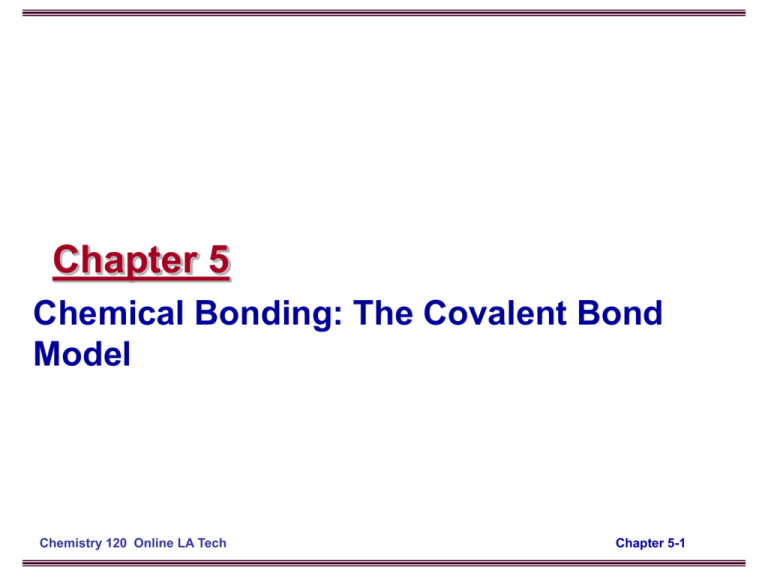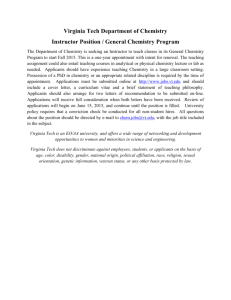chapter-5-stoker
advertisement

Chapter 5 Chemical Bonding: The Covalent Bond Model Chemistry 120 Online LA Tech Chapter 5-1 What’s the fuel in space shuttle? → CO 5.1 Space Shuttle liftoff NASA Chemistry 120 Online LA Tech Chapter 5-2 Hydrogen molecule: A covalent bond Fig. 5.1 Electron sharing can occur only when electron orbitals from two different atoms overlap. Chemistry 120 Online LA Tech Chapter 5-3 Number of covalent bonds and Lewis symbol ← Fig. 5.2 The number of covalent bonds formed by a nonmetallic element is directly correlated with the number of electrons it must share in order to obtain an octet of electrons. Chemistry 120 Online LA Tech Chapter 5-4 Covalent and Coordinate covalent Bond Fig. 5.3 (a) A “regular” covalent single bond is the result of overlap of two half-filled orbitals. (b) A coordinate covalent single bond is the result of overlap of a filled and a vacant orbital. Chemistry 120 Online LA Tech Chapter 5-5 Molecular structure → Fig. 5.4 The sulfur dioxide molecule. Chemistry 120 Online LA Tech Chapter 5-6 Pyramidal molecule → Fig. 5.5 The phosphorus trifluoride molecule. Chemistry 120 Online LA Tech Chapter 5-7 Linear Molecule ← Fig. 5.6 The hydrogen cyanide molecule. Chemistry 120 Online LA Tech Chapter 5-8 Unpaired electrons CC 5.1 Chemistry 120 Online LA Tech Chapter 5-9 Polyatomic ions held by covalent bonds → Fig. 5.7 The sulfate ion. Chemistry 120 Online LA Tech Chapter 5-10 Electron pair repulsions ← Fig. 5.8 Arrangement of valence electron pairs about a central atom that minimize repulsions between the pairs. Chemistry 120 Online LA Tech Chapter 5-11 Where you find covalent molecules? CC 5.2 Chemistry 120 Online LA Tech Chapter 5-12 Space filling models Fig. 5.9 (a) Acetylene molecule. (b) Hydrogen peroxide molecule. (c) Hydrogen azidde molecule. Chemistry 120 Online LA Tech Chapter 5-13 VSEPR theory and molecular geometry Chemistry 120 Online LA Tech Chapter 5-14 Linus Pauling and Electronegativity ← Fig. 5.10 Linus Pauling received the Nobel Prize in chemistry in 1954 for his work on the nature of the chemical bond. © Bettman/CORBIS Chemistry 120 Online LA Tech Chapter 5-15 Electronegativity Trends → Fig. 5.11 Abbreviated periodic table showing Pauling electronegativity values for selected representative elements. Chemistry 120 Online LA Tech Chapter 5-16 Polarity in heteonuclear diatomic molecules ← Fig. 5.12 (a) In the nonpolar covalent bond present, there is a symmetrical distribution of electron density. (b) In the polar covalent bond present, electron density is displaced because of its electronegativity. Chemistry 120 Online LA Tech Chapter 5-17 Types of covalent bond CAG 5.2 Chemistry 120 Online LA Tech Chapter 5-18 Predicting polarity of molecule → Fig. 5.13 (a) Methane is a nonpolar tetrahedral molecule. (b) Methyl chloride is a polar tetrahedral molecule. Chemistry 120 Online LA Tech Chapter 5-19 Prefixes for naming covalent compounds → Table 5.1 Chemistry 120 Online LA Tech Chapter 5-20 Common names of covalent compunds → Table 5.2 Chemistry 120 Online LA Tech Chapter 5-21 Naming covalent compounds ← Fig. 5.14 The tetraphosphorous decoxide molecule. Chemistry 120 Online LA Tech Chapter 5-22






